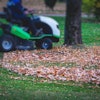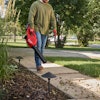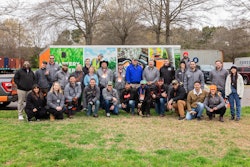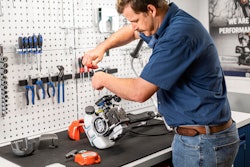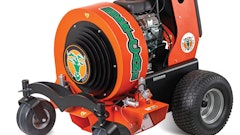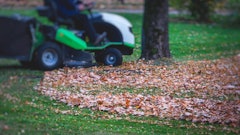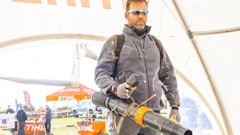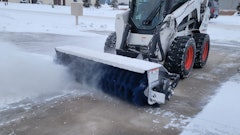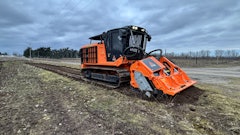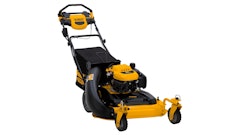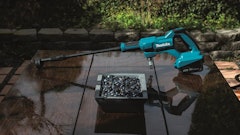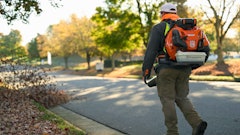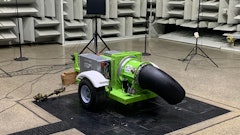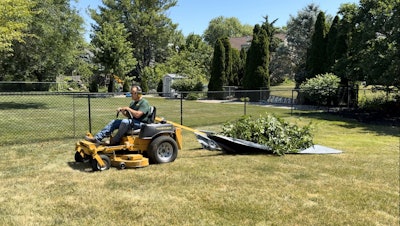
Whether it be leaves, sticks, grass clippings, hedge trimmings, walnuts or something else, landscape pros in select regions will likely encounter some type of debris during fall.
How they go about performing debris management may depend on several factors.
“It’s property specific and client specific to assess the best most efficient way to perform fall cleanups,” says Aaron Farrer, president and founder of Practical Products.
Farrer, Nick Carlson, founder and CEO of Mulch Mate, and Ron Scheffler, senior product manager at Bobcat Co., provide advice on how landscape pros can safely and effectively handle debris management this fall cleanup season.
Right tool for the job
First and foremost, landscape pros need to come prepared with the right tool for the job, Farrer says.
“One tool by itself may not be the best way to get a job done,” Farrer says. “Sometimes that's a combination of things, whether it's the leaf blower, tarp, rake or a combination.”
Farrer adds that for certain jobs, such as big properties with wet leaves, simply using a gas blower may not be the most effective way to perform cleanups.
“I've seen other crews deploy anywhere from three to 10 people with leaf blowers, and they're all burning gas and just blowing leaves that are wet and harder to move,” Farrer says. “They're deploying incredible manpower and burning gas the whole time, when if they would lay down a big tarp and fill that up and then drag it out, that would be more efficient than having 10 people doing the same thing.”
Scheffler adds that there are so many mower attachments and accessories that can help with fall cleanups, including rear collection systems, whether it’s dumped from the seat or manual removal of the bags; fabric or metal side bags that are smaller and less expensive; mulching kits that break down the leaves and clippings, allowing for more nutrients to soak back into the soil; a front end leaf plow that can help landscape pros get the leaves to the curb if they don’t have time to collect; as well as stand-on or walk-behind blowers to help gather leaves and save on labor.
Scheffler notes that mulching, as long as clients are OK with the leftover debris, not only helps maintain a nutrient-rich lawn, but it also can aid with the labor shortage.
“The labor shortage hasn’t gone away,” Scheffler says. “Since COVID, people are more attuned to the environment, and they want to maintain something nice. With mulching, the landscaper comes in to do a job and still gets paid, but now he's faster at it, because he doesn't have to take the clippings out and put them at the curb.”
Carlson agrees that using a mower and various accessories like a cart can help landscape professionals become even more efficient in their leaf cleanups.
He adds that with a mower, landscape pros are taking a large swipe at the leaves each time, and the mower blades are effectively chopping up the leaves, like a leaf vac would do.
However, he cautions that this technique would not work with items like flower beds—landscape pros would still have to blow those out.
Carlson also suggests a trailer that’s specifically for leaves.
“You have more capacity, you have full control, more ventilation and you can see exactly what you're doing,” Carlson says.
Finally, regarding the mowing season, Scheffler cautions that landscape pros should not stop mowing immediately once cooler weather hits.
“You want to maintain that shorter grass heading into the winter months to allow the sun to do its job, and it also will help that grass (in) spring growth to come back more lush, and not have as tough of a job doing spring cleanup,” Scheffler says. "Also, don't forget to enjoy those colors that emerge in the fall when you're hustling out on the jobsite."
Selling the job
To let customers know that you offer fall cleanup services, Scheffler recommends reaching out in mid to late August.
"That would be a great time to say, 'hey, look, if you've been happy with the work I've been doing, and if you want to keep it looking sharp, I also offer these services,'" Scheffler says. "Fall aeration is also a great service to offer. They could start advertising for what they offer."
Carlson notes that it’s important to keep in mind that some customers want to feel served, rather than sold.
“I had one customer who was upset that I kept charging her for all my different services, but really, she wanted a contract where she could pay the same dollar figure every single month,” Carlson says. “That way, she didn’t feel nickeled and dimed. You’re not necessarily selling a service. You’re selling a package, a total solution.”
Finally, Carlson recommends staying professional.
“When a customer calls a landscaper and they want a service, they need you to be the professional and hold their hand,” Carlson says. “Be the professional they need you to be.”
Safety is key
As with every other landscape service, green industry pros should ensure they are using safe practices when performing fall cleanup and debris management services.
First, Farrer says, landscape pros should be aware of their surroundings.
"One of the glaring problems with using a tarp and going from point A to point B is that landscapers can't see where they're going, and it's not uncommon for landscapers to encounter divots in the yard, so it could be easy to roll an ankle," Farrer says.
Scheffler adds that obstacles such as sprinklers and toys can also be hidden in fall debris.
"Come springtime, everyone loves cutting their lawn, but come late summer, it can be a chore and so clients' grass gets a little longer," Scheffler says.
To help keep awareness up, Scheffler recommends walking the property before starting services, even on properties they've encountered before, and marking things like sprinkler heads with a flag.
"Even on those properties you know well, I would do a yard sweep and make sure that there's nothing hiding," Scheffler says. "Take that extra moment because you could end up doing thousands of dollars worth of damage to your equipment, someone's house or even worse."
Fall isn't the same everywhere
Nick Carlson, founder and CEO of Mulch Mate, notes that while many states in the U.S. will primarily deal with leaves as debris in the fall, other states, such as Florida, will deal with other issues.
“The guys in Florida are mulching in December, whereas where I am in Annapolis, Maryland, we’re mulching in March," Carlson says.
Follow the QR code to hear more from Carlson on how different regions within the U.S. will take different approaches.


